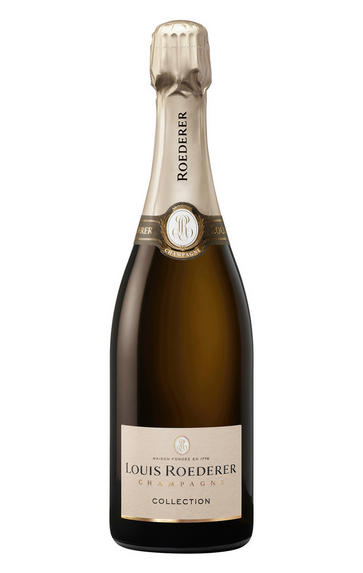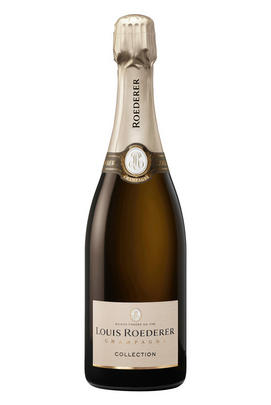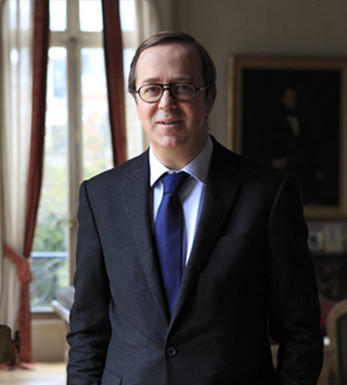
Champagne Louis Roederer, Collection 243, Brut

Critics reviews
One-third each of Pinot Noir, Chardonnay and Pinot Meunier. Collection 243 is their new cuvée, replacing Brut Premier NV. A higher percentage of specific vintage reserve wines aged in oak (10%) and a blend of their perpetual reserve (34%), first created in 2012, is used as the base plus selected wines from the current harvest (2017).
243 represents the number of different blended wines released by the house since being founded in 1776. Almost 80% of the fruit comes from their 240 ha of vineyards across the Montagne de Reims, Marne Valley and Côtes des Blancs. Each plot was vinified separately before blending, bottling and lees-ageing for three years and aged for six months post disgorgement.
Winemaker Jean-Baptiste Lecaillon. RS 8 g/l. Vegan. Natural cork. Bottle weight 835 g. Available in over 200 shops.
Subtle, muted nose promising riches beyond. Many-layered with quite a strong streak of lime. Lively, long and complex. Sophisticated, offering more than just age. Persistence, too – in fact, it builds on the end like a fine burgundy.
Drink 2023 - 2028
Jancis Robinson MW, JancisRobinson.com (June 2023)
Based on the 2018 vintage and complemented by reserve wines from a solera established in 2012, as well as younger foudre-aged reserve wines, Roederer's newly released NV Brut Collection 243 is a pillowy, enveloping Champagne evocative of crisp stone fruits, honeycomb, white flowers and buttery pastry. Medium to full-bodied, fleshy and generous, with an ample core of fruit, bright acids and a saline finish, it will offer demonstrative drinking on release.
Drink 2021 - 2035
William Kelley, Wine Advocate (August 2022)
Dried-lemon, apricot, green-apple, salted-almond, walnut and light caramel notes. Vinous and layered, with small and tight bubbles. Excellent focus and intensity. Based on 2018, with reserve wines going back to 2009. Dosage 8g/L.
Drink now
James Suckling, JamesSuckling.com (June 2022)
A crystalline and pure nose full of bright lemon, chamomile, green apple and soft honeysuckle. Crisp and dry, with racy acidity and tiny bubbles that lift the palate straight away.
It is mouthwatering but light and so fine in terms of texture with a chalky, long and softly salty finish. This really makes you want another glass straight away.
It is a perfect aperitif wine still with lots of juice and fruity flavours but crisp and totally refreshing. The majority of this blend comes from the 2018 vintage.
Drink 2023 - 2030
Georgina Hindle, Decanter.com (June 2023)
The NV Champagne Collection 243 Brut is the third release and is based on the 2018 vintage, with the addition of 30% of the perpetual reserve started in 2012 and 10% reserve wine that has been aged in oak.
It is ripe and balanced, with yellow flowers, honeycomb, and plum, and it has elegant concentration and underlying tension, precise mousse, and rich salinity, with lingering notes of croissant and delicate smoke. This will be an exciting wine in the range to follow.
Drink 2022 - 2037
Audrey Frick, JebDunnuck.com (November 2022)
About this WINE

Louis Roederer
Founded in 1776, Louis Roederer is a family-owned, independent Champagne house with a well-deserved reputation for quality. It is managed by Frédéric Rouzaud, the seventh generation to be at the helm.
In 1876, Louis Roederer created the now-famous Cristal at the request of Alexander II. This once intensely sweet wine is now one of the most luscious, deeply flavoured champagnes available, with the '88, '89 and '90 among the greatest Cristals ever released.
Louis Roederer’s best-selling non-vintage blend for almost 40 years, Brut Premier, has recently been replaced by Collection 242. This new multi-vintage blend was created by Chef du Caves Jean-Baptiste Lécaillon in response to increasingly warm vintages. The cuvée aims to capture freshness and is based on a perpetual reserve which focuses on acidity and minerality.

Brut Champagne
Brut denotes a dry style of Champagne (less than 15 grams per litre). Most Champagne is non-vintage, produced from a blend from different years. The non-vintage blend is always based predominately on wines made from the current harvest, enriched with aged wines (their proportion and age varies by brand) from earlier harvests, which impart an additional level of complexity to the end wine. Champagnes from a single vintage are labelled with the year reference and with the description Millésimé.
Non-vintage Champagnes can improve with short-term ageing (typically two to three years), while vintages can develop over much longer periods (five to 30 years). The most exquisite and often top-priced expression of a house’s style is referred to as Prestige Cuvée. Famous examples include Louis Roederer's Cristal, Moët & Chandon's Dom Pérignon, and Pol Roger's Cuvée Sir Winston Churchill.
Recommended Producers : Krug, Billecart Salmon, Pol Roger, Bollinger, Salon, Gosset, Pierre Péters, Ruinart

Champagne blend
Which grapes are included in the blend, and their proportion, is one of the key factors determining the style of most Champagnes. Three grapes are used - Pinot Noir, Chardonnay and Pinot Meunier.
26% of vineyards in Champagne are planted with Chardonnay and it performs best on the Côtes des Blancs and on the chalk slopes south of Epernay. It is relatively simple to grow, although it buds early and thus is susceptible to spring frosts. It produces lighter, fresher wines than those from Burgundy and gives finesse, fruit and elegance to the final blend. It is the sole grape in Blancs de Blancs, which are some of the richest long-lived Champagnes produced.
Pinot Noir accounts for nearly 40% of the plantings in Champagne and lies at the heart of most blends - it gives Champagne its body, structure, strength and grip. It is planted across Champagne and particularly so in the southern Aube district.
The final component is Pinot Meunier and this constitutes nearly 35% of the plantings. Its durability and resistance to spring frosts make the Marne Valley, a notorious frost pocket, its natural home. It ripens well in poor years and produces a soft, fruity style of wine that is ideal for blending with the more assertive flavours of Pinot Noir. Producers allege that Pinot Meunier lacks ageing potential, but this does not deter Krug from including around 15% of it in their final blends.


Buying options
Add to wishlist
Description
The Collection 243 (the 243rd blend from Louis Roederer) is based on the 2018 vintage – a vintage which will be revered for years to come. The nose is elegantly expressive, with a harmonious combination of toasty notes and vibrant, ripe citrus.
Flavours of sweet lemon biscuits and shortbread are carried with invigorating acidity, adding a wonderful tension. I think it’s worth cellaring a few of these too. It will develop wonderfully and a small collection will be an enviable thing to have.
Drink now to 2028
Charlie Leech, Buying Assistant, Berry Bros. & Rudd (August 2023)
wine at a glance
Delivery and quality guarantee